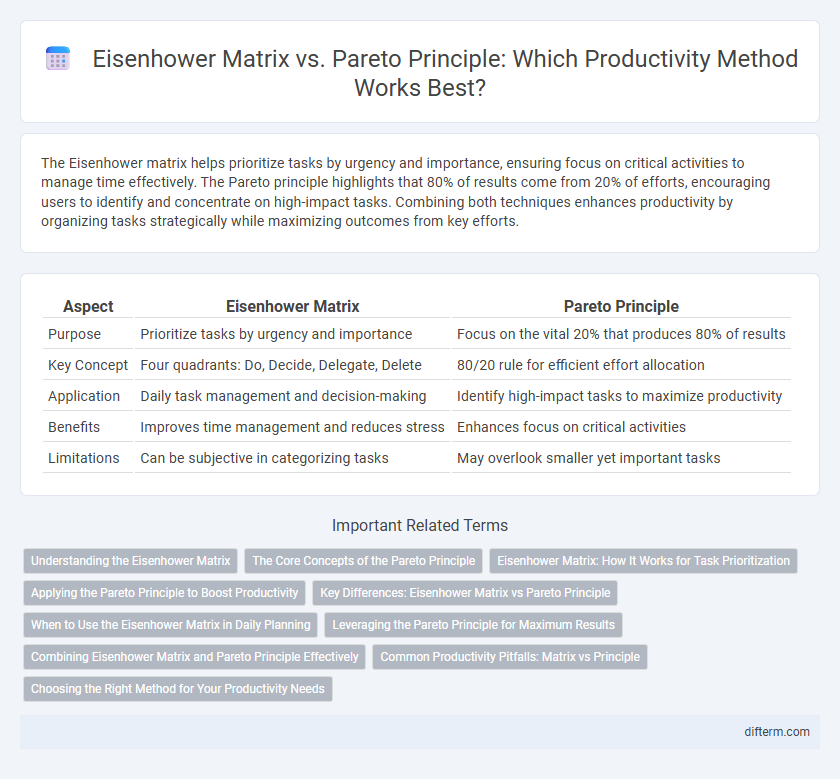The Eisenhower matrix helps prioritize tasks by urgency and importance, ensuring focus on critical activities to manage time effectively. The Pareto principle highlights that 80% of results come from 20% of efforts, encouraging users to identify and concentrate on high-impact tasks. Combining both techniques enhances productivity by organizing tasks strategically while maximizing outcomes from key efforts.
Table of Comparison
| Aspect | Eisenhower Matrix | Pareto Principle |
|---|---|---|
| Purpose | Prioritize tasks by urgency and importance | Focus on the vital 20% that produces 80% of results |
| Key Concept | Four quadrants: Do, Decide, Delegate, Delete | 80/20 rule for efficient effort allocation |
| Application | Daily task management and decision-making | Identify high-impact tasks to maximize productivity |
| Benefits | Improves time management and reduces stress | Enhances focus on critical activities |
| Limitations | Can be subjective in categorizing tasks | May overlook smaller yet important tasks |
Understanding the Eisenhower Matrix
The Eisenhower Matrix, also known as the Urgent-Important Matrix, is a time management tool that helps prioritize tasks based on urgency and importance, dividing activities into four quadrants. It enables users to focus on high-impact tasks that drive productivity by categorizing work into urgent and important, important but not urgent, urgent but not important, and neither urgent nor important. This structured approach empowers individuals to allocate time efficiently, reduce stress, and improve decision-making, contrasting with the Pareto Principle's focus on the 20% of activities that generate 80% of results.
The Core Concepts of the Pareto Principle
The Pareto Principle, also known as the 80/20 rule, emphasizes that roughly 80% of results come from 20% of efforts, highlighting the importance of identifying and focusing on high-impact tasks. This principle guides productivity by encouraging prioritization of the most effective activities that yield the greatest outcomes. Unlike the Eisenhower Matrix, which categorizes tasks by urgency and importance, the Pareto Principle directs attention to the few vital inputs driving the majority of productivity gains.
Eisenhower Matrix: How It Works for Task Prioritization
The Eisenhower Matrix organizes tasks into four quadrants based on urgency and importance, enabling users to prioritize effectively by focusing on high-impact activities first. This method visually separates critical tasks that need immediate attention from less urgent ones, ensuring time management aligns with long-term goals. By categorizing duties as urgent-important, important-not urgent, urgent-not important, and neither, the matrix improves decision-making and reduces procrastination in productivity workflows.
Applying the Pareto Principle to Boost Productivity
Applying the Pareto Principle, also known as the 80/20 rule, boosts productivity by identifying and focusing on the 20% of tasks that generate 80% of results. Unlike the Eisenhower Matrix, which prioritizes tasks based on urgency and importance, the Pareto Principle directs efforts toward high-impact activities that yield the greatest outcome. This approach streamlines workflow, maximizes efficiency, and reduces time wasted on low-value tasks.
Key Differences: Eisenhower Matrix vs Pareto Principle
The Eisenhower Matrix prioritizes tasks based on urgency and importance, dividing them into four quadrants to manage time effectively, while the Pareto Principle emphasizes focusing on the 20% of tasks that generate 80% of the results. The matrix is a decision-making tool for immediate action planning, whereas the Pareto Principle serves as a productivity strategy identifying high-impact activities. Both frameworks enhance efficiency but differ in application: task categorization versus outcome prioritization.
When to Use the Eisenhower Matrix in Daily Planning
The Eisenhower Matrix is ideal for daily planning when tasks vary widely in urgency and importance, enabling focused prioritization between critical, time-sensitive actions and less urgent activities. It helps in quickly categorizing tasks into four quadrants, improving decision-making by highlighting what requires immediate attention versus what can be delegated or deferred. This method enhances productivity by preventing overwhelm and ensuring that daily efforts align with long-term goals and urgent deadlines.
Leveraging the Pareto Principle for Maximum Results
Leveraging the Pareto Principle focuses on identifying the 20% of tasks that generate 80% of productivity outcomes, enabling efficient allocation of time and resources for maximum impact. Unlike the Eisenhower matrix, which categorizes tasks by urgency and importance, the Pareto Principle directly targets high-leverage activities that drive significant results. Prioritizing these critical tasks enhances productivity by minimizing effort on less impactful work and accelerating goal achievement.
Combining Eisenhower Matrix and Pareto Principle Effectively
Combining the Eisenhower Matrix and Pareto Principle enhances productivity by categorizing tasks based on urgency and impact while focusing on the vital 20% that yields 80% of results. This strategic approach ensures prioritization of high-impact, urgent activities, streamlining decision-making and resource allocation. Integrating these methods maximizes efficiency by targeting essential tasks that drive the most significant outcomes within critical timeframes.
Common Productivity Pitfalls: Matrix vs Principle
Common productivity pitfalls emerge when users misapply the Eisenhower Matrix and Pareto Principle, such as over-categorizing tasks in the matrix without prioritizing high-impact activities identified by the Pareto principle's 80/20 rule. Misinterpreting the Eisenhower Matrix often leads to spending excessive time on urgent but low-value tasks, while neglecting the critical 20% of tasks that generate most results emphasized by Pareto. Balancing these tools effectively requires focusing on high-value tasks and avoiding diffusion of effort across non-essential activities that hinder overall productivity.
Choosing the Right Method for Your Productivity Needs
The Eisenhower Matrix categorizes tasks by urgency and importance, enabling focused prioritization for immediate action or delegation, while the Pareto Principle emphasizes identifying the critical 20% of efforts that yield 80% of results to maximize efficiency. Selecting the right method depends on whether your productivity challenge involves managing time-sensitive tasks or optimizing impact from limited resources. Combining these approaches can create a balanced strategy, leveraging urgent task management alongside high-impact activity focus to enhance overall productivity.
Eisenhower matrix vs Pareto principle Infographic

 difterm.com
difterm.com